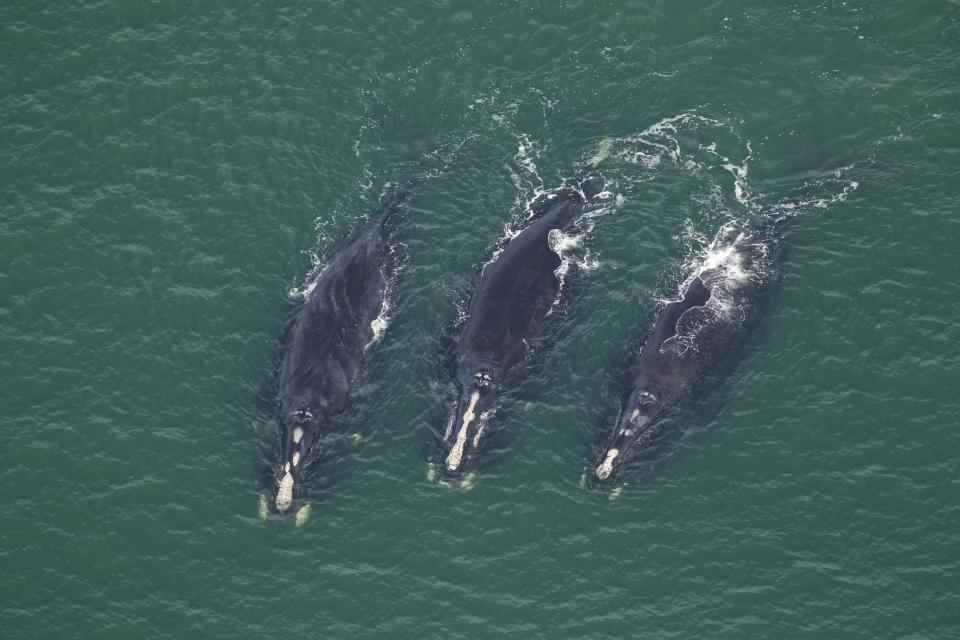Don't be ruled by greed and fear; whales are dying and it's up to us to save them | Opinion
Living in Fernandina Beach is special. We are surrounded by unparalleled beauty. Situated as the northernmost city along Florida’s Atlantic coastline, our community sits at the confluence of the Amelia River, St. Mary’s River and the Atlantic Ocean.
Every winter our community prepares a welcome for a unique seasonal visitor: the critically endangered North Atlantic right whale. This whale is cherished here in Northeast Florida and is very much a part of the cultural fabric of our community. In fact, we have recognized November as North Atlantic Right Whale Month, and each year we host the annual Right Whale Festival that brings thousands of whale lovers and raises awareness about their precarious situation.
Our citizens feel so strongly about protecting these whales that we were one of the first coastal communities to pass resolutions against seismic activity and offshore drilling operations. We’ve also traveled to our nation’s capital to meet with lawmakers and advocate for better protection of “our” whales.

Many residents are aware that North Atlantic right whales face an uncertain future and could possibly go extinct if we don’t take action to protect them. That’s why folks in our community were encouraged to hear about the new vessel speed rule proposed by the National Oceanic & Atmospheric Association (NOAA). Despite this good news, we’ve heard a lot of unfounded fear mongering and few facts from the Florida boating industry. The truth is, our government is long overdue to put adequate, science-based protections in place for the critically endangered North Atlantic right whale. With the recently announced declines in the species and the number of breeding females, these new safeguards are exactly what's needed.
As we speak, right whale mothers are heading towards the warm coastal waters of Florida to breed and hopefully birth new calves. Each birth offers a chance for the species to renew itself, but unfortunately, the Fisheries Service has failed to implement adequate protections for right whales as required by law. After having their calves, North Atlantic right whale mothers begin their slow journey back northward where they will face the threat of thousands of speeding boats in their migratory zone. Each year these mothers make this perilous journey with their calves and have been seen along the coast from Fernandina to Melbourne Beach.
More:NOAA wants boats 35 feet or longer along the Space Coast to slow for right whales
Feds warn it's wrong to approach endangered right whales
The boating industry has been vocal about their opposition to the proposed rule, hypocritically claiming they care about whales yet don’t want to make any changes to save them. Slowing down boat traffic, which may add an extra hour or two of travel time is not too much to ask when the survival of the species is on the line. Furthermore, the proposed slow zones are seasonal and only in effect for the months of the year when mothers and calves are in the area.
The reason for NOAA’s new proposal is that boat collisions remain a top cause of death for these whales. Current speed regulations apply to vessels longer than 65 feet, and the proposed rule extends to include smaller boats longer than 35 feet. For context, an average adult North Atlantic right whale is 52 feet long.

Smaller boats can and do hit North Atlantic right whales. In an infamous case just last year a 54-foot charter boat traveling at 21 knots struck and killed a mother named 'Infinity' and her calf near St. Augustine, Florida. The dead calf washed ashore the next day with blunt force trauma injuries, including deep propeller cuts on its head and back, broken ribs, and bruising. The boat that hit them was so damaged the captain had to run it aground before it sank. Had NOAA’s proposed vessel speed rule been in place at the time, a gruesome tragedy like this could have been avoided.
Multiple studies have shown that slowing boats to 10 knots in areas where North Atlantic right whales swim can decrease their likelihood of being killed by a boat strike by 80-90%.
Visually, these slow-swimming whales are notoriously hard to see while navigating a boat, as they are dark in color and lack a dorsal fin. Slowing boat traffic down gives them a chance to be spotted before a collision.
There are only about 340 North Atlantic right whales left on the planet, including less than around 70 breeding females. They have been swimming our oceans for thousands of years and they don’t deserve to get pushed into extinction, especially when we already know what to do to turn it around. Every single death puts their survival in jeopardy.
It’s up to us to save them.
Every industry evolves and innovates over time, and the commercial and recreational boating industry is no different. Boat traffic can and must adapt to slower speeds.
Change is scary to some, but it’s what’s right for the survival of this species.
John A. Miller, U.S. Navy Retired and Former Mayor City of Fernandina Beach. Support local journalism and become a subscriber. Visit floridatoday.com/subscribe
This article originally appeared on Florida Today: Right whales are dying but slower boat speeds can save them

